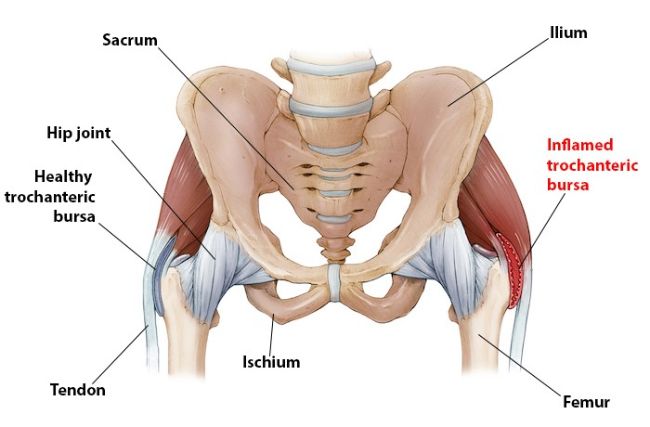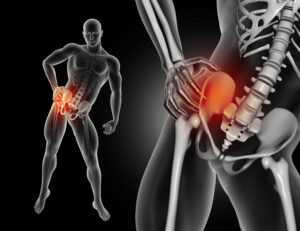Bursitis is a painful bursal swell. Your tendons, ligaments, and muscles are cushioned by bursa, which are sacs filled with fluid. Bursa aid in the smooth movement of tendons, ligaments, and muscles over bone when they function appropriately. However, the region around the bursae becomes extremely tender and unpleasant when they swell. Hip bursa that are affected by trochanteric bursitis enlarge.
Bursitis is not just a hip problem. It can also happen in the elbow, knee, and shoulder joints. Acute bursitis, which is transient, or persistent bursitis (long-lasting).

Overview
What is Hip Bursitis?
Trochanteric bursitis refers to painful swelling adjacent to the hip joint, constituting a specific form of bursitis. Bursitis entails inflammation of a small, fluid-filled sac known as a bursa, which serves to cushion spaces around bones and tissues, akin to protective bubble wrap. Located where the thigh bone (femur) meets the pelvis, the hip joint features the greater trochanter, a protruding upper, outer edge of the femur. Trochanteric bursitis occurs when the bursa covering this greater trochanter sustains damage, inflammation, or irritation. Seeking medical attention is advisable if experiencing hip discomfort, particularly if the pain exacerbates or persists beyond a couple of weeks.
Types of hip bursitis-
It can manifest in bursae located either externally or internally within the hip. The specific type depends on the affected bursa and whether it’s infected. The primary varieties include:
- Trochanteric bursitis: Inflammation of the bursae around the trochanter, the bony prominence at the top of the thigh bone on the outer hip. This condition, trochanteric bursitis, typically causes pain on the outer hip and thigh.
- Iliopsoas bursitis or ischial bursitis: This condition arises when the bursae located on the inner side of the hip, near the groin, become inflamed, leading to discomfort in the groin or upper buttock area.
- Septic hip bursitis: When hip bursae become infected, it’s termed septic hip bursitis. This condition can be severe, accompanied by additional symptoms like fever, fatigue, and malaise.Whether one is diagnosed with hip bursitis or is uncertain about the cause of their hip pain, our orthopedic team offers assistance. We can pinpoint the origin of the pain and provide personalized treatment plans for bursitis, incorporating integrative approaches such as acupuncture, physical therapy, and, if necessary, minimally invasive surgery to restore comfortable mobility.
Symptoms & Causes
Symptoms of Hip bursitis
- Hip pain
- Dull ache or stiffness in the joint or nearby area
- Pain during movement
- Joint swelling
- Skin warmth around the joint
- Redness in the skin surrounding the joint
Causes
Causes which contribute to Hip Bursitis are:
- Repetitive strain or excessive use of the hip.
- Rheumatoid arthritis.
- Gout.
- Pseudogout.
- Hip injuries.
- Bacterial infection, like Staphylococcus aureus (staph infection).
- Diabetes.
- Spinal issues such as scoliosis.
- Discrepancy in leg lengths.
- Bone spurs (abnormal bony growths on the hip).
Prevention & Risks
Prevention
Although not all forms of bursitis can be entirely prevented, you can mitigate your risk and lessen the severity of flare-ups by adjusting how you perform certain tasks. Here are some examples:
- Utilizing kneeling pads: If your occupation or pastime involves frequent kneeling, employ some form of padding to alleviate pressure on your knees.
- Practicing proper lifting techniques: When lifting, remember to bend your knees to reduce strain on the bursae in your hips.
- Employing wheeled devices for heavy loads: Instead of carrying heavy loads, which can stress the bursae in your shoulders, opt for a dolly or wheeled cart.
- Taking regular breaks: Alternate repetitive tasks with periods of rest or engage in different activities to avoid overstraining your joints.
- Maintaining a healthy weight: Excess weight can increase stress on your joints, so strive to maintain a healthy body weight.
- Engaging in regular exercise: Strengthening your muscles can provide added protection for your joints.
- Warming up and stretching before vigorous activities: Prior to engaging in strenuous activities, ensure you warm up adequately and stretch to safeguard your joints against injury.
Risk Factors
While bursitis can affect anyone, certain factors may heighten your susceptibility:
- Age: Bursitis becomes more prevalent as you age.
- Occupations or pastimes: Engaging in activities or professions involving repetitive movements or pressure on specific bursae raises the likelihood of bursitis. Examples include carpet laying, tile setting, gardening, painting, and playing musical instruments.
- Underlying medical conditions: Certain systemic diseases and ailments such as rheumatoid arthritis, gout, and diabetes elevate the risk of developing bursitis. Additionally, being overweight increases the likelihood of hip and knee bursitis.
Diagnosis
Healthcare providers employ various tests to diagnose trochanteric bursitis, which may include:
- X-rays
- Ultrasound or MRI (magnetic resonance imaging) to capture images of the inflamed bursa.
Treatment
Non-Surgical Approaches
The primary treatment for hip bursitis typically doesn’t involve surgery. Many individuals find relief from hip bursitis through simple lifestyle adjustments, including:
- Modifying activities: Avoiding activities that exacerbate symptoms.
- Nonsteroidal anti-inflammatory drugs (NSAIDs): Pain relief and inflammation control can often be achieved with medications like ibuprofen, naproxen, piroxicam, celecoxib, and others. It’s essential to use NSAIDs cautiously and for short durations. Consult your doctor regarding the appropriate NSAIDs for your condition, as they may have adverse effects if you have specific medical conditions or are taking certain medications.
- Assistive devices: Using a walking cane or crutches when necessary for a week or longer.
- Physical therapy: Your doctor might recommend exercises to stretch the iliotibial (IT) band and/or improve hip strength and flexibility. These exercises can be performed independently or under the guidance of a physical therapist, who may incorporate additional treatments such as massage, ice, heat, or ultrasound.
- Steroid injection: Injecting a corticosteroid with a local anesthetic can help alleviate hip bursitis symptoms. This straightforward and effective procedure can be performed in the doctor’s office with a single injection into the bursa. The injection may provide temporary relief for several months or longer. If pain and inflammation recur, another injection a few months after the initial one may be beneficial. However, it’s crucial to determine the underlying cause of the bursitis for definitive treatment. It’s important to limit the frequency of injections, as prolonged use of corticosteroid injections can potentially harm surrounding tissues.
Surgical Intervention
Surgery is seldom required for treating hip bursitis. If the bursa remains inflamed and painful despite attempting all nonsurgical options, your doctor might suggest surgically removing the bursa. Removing the bursa does not impair hip function, and the hip can operate normally without it.
A newer approach gaining traction is arthroscopic bursa removal. In this method, the bursa is extracted through a small (1/4-inch) incision above the hip. A tiny camera, or arthroscope, is inserted through another incision, allowing the doctor to utilize miniature surgical instruments for bursa removal. This procedure is less invasive, leading to quicker and less painful recovery compared to open surgery.
Both types of surgeries are typically performed as outpatient procedures, eliminating the need for an overnight hospital stay. Initial research indicates that arthroscopic bursa removal is highly effective, although ongoing studies continue to evaluate its efficacy. Read more about Hip Replacement.
